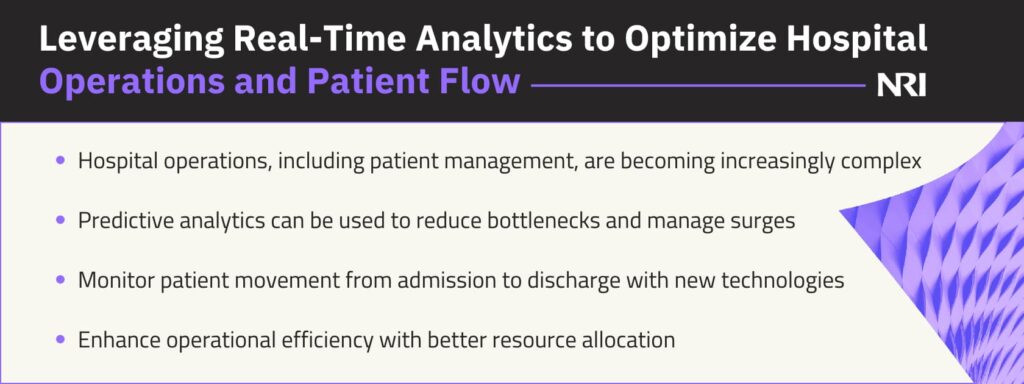Hospitals are increasingly relying on real-time analytics to optimize their operations and improve patient care

Hospitals are pressured to deal with increased demand, improve operations, and provide better patient management. While many healthcare institutions once had a conservative approach to adopting new technology, today’s demands require innovative solutions.
Real-time analytics are becoming critical to optimize hospital operations and improve patient flow.
Healthcare data analytics promise to enhance how healthcare operations operate and provide services by transforming how they gather, interpret, and apply data.
An essential part of revolutionizing patient care is using powerful technologies such as artificial intelligence (AI), improving diagnoses, delivering personalized treatment plans, optimizing staff scheduling, and doing much more.
Challenges in Hospital Operations and Patient Flow
News sources point out that the state of hospital ERs is critical. “Across the U.S., ER patients who need to be hospitalized find themselves stuck in hallways or waiting rooms, sometimes for days or weeks, before they are able to get further care,” points out NBC News.
The statistics are alarming. About 28% of ER doctors surveyed claimed patients were forced to stay in the ER for more than two weeks before getting a hospital bed.
Of course, underfunding and understaffing play their part in these problems. But inefficient bed management and resource allocation are also culpable, as well as relying on manual processes that hinder timely decision-making.
Real-time analytics for hospitals can be used to deliver better patient care (and enable patients to be more involved in their own care) and automate and improve processes and decisions.
How Real-Time Analytics Addresses These Challenges
With real-time data analytics, hospitals can optimize operational processes, improve patient treatment, and boost strategic decision-making. Healthcare organizations can draw on four types of analytics, including:
- Descriptive analytics: These involve leveraging historical data to glean insights and understanding into trends and patterns. For example, patient treatment histories, outcomes, and medical records might be used to identify common admissions reasons or track how certain infections are cropping up in different departments.
- Diagnostic analytics: Involve digging deep into data to determine why specific outcomes occurred. For example, it might examine why certain populations are at high risk for particular diseases.
- Predictive analytics: Involve forecasting future outcomes by leveraging data, statistical algorithms, and machine learning (ML) techniques. This approach provides insights into potential scenarios, such as identifying individuals at higher risk of developing chronic conditions based on their health records and lifestyle factors. Additionally, predictive analytics can enhance operational efficiency by anticipating bottlenecks and optimizing staffing during expected demand surges.
- Prescriptive analytics: This data enables healthcare providers to make better patient care, treatment strategies, and resource allocation decisions. For example, data might be mined from a patient’s records and those with a similar condition to determine the best treatment for someone suffering a particular condition.
Key Benefits of Real-Time Analytics in Hospitals
Real-time analytics for hospitals provide several vital benefits. These include:
Improved Patient Care
Real-time analytics for hospitals can be used to mine patient electronic health records (EHRs) to gain valuable insights that doctors can use to guide treatment recommendations. Data such as nursing notes and progress reports can be used to identify diagnostic patterns, detect small condition changes, and even prioritize patients with deteriorating health conditions. Preventative diagnostics can flag those who are more at risk for certain conditions, such as hypertension or diabetes.
Better Patient Engagement
New technologies enable patients to take a more significant part in their own care. Various portable digital monitors allow them to convalesce in the comfort of their homes while tracking their health progress and alerting their healthcare provider if a status change requires quick intervention.
These can include:
- Vital signs monitors
- Blood pressure monitors
- Glucometers
- Pulse oximeters
- Sleep monitors
- Neurological monitoring devices
- Wearable devices (Fitbits, etc.)
Data from monitoring devices can be used to make better diagnoses and recommend preventive treatments.
Patient portals can also be employed to give people access to their medical data, helping to make them more active participants in their own care.
Improved Operational Efficiency
Real-time analytics can be leveraged to optimize hospital operations, highlighting inefficiencies, streamlining processes, and improving resource allocations. Health organizations might use them, for example, to forecast peak patient demand times so they can staff up. Improved care will also help to make for happier patients, who receive timely attention through data-driven decisions.
Hospitals can focus on improving processes and reducing waste. Data can also be used to reduce the incidence of unnecessary medical procedures and to cut back on readmissions.
NRI’s Solutions for Real-Time Healthcare Analytics
NRI understands how new tools and technologies can be game changers for healthcare operations. After all, we have provided strategic paths for harnessing today’s most powerful technologies to some of the country’s top healthcare providers.
We bring relief and welcome help to doctors, nurses, and hospital staff to better collaborate to improve care. We understand that patients aren’t the only hospital end users. Giving doctors and staff real-time data solutions is equally important so they can do their jobs more effectively and thrive in their roles.
Your first step in implementing real-time data solutions is to set up a conversation with one of the NRI experts.



